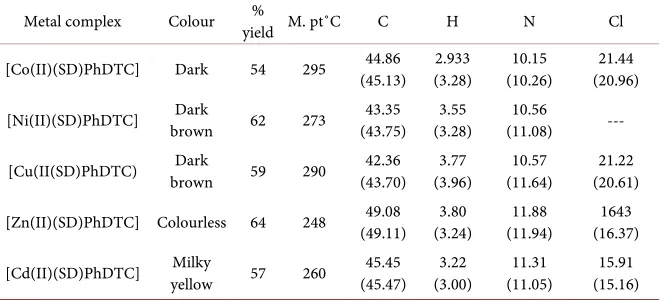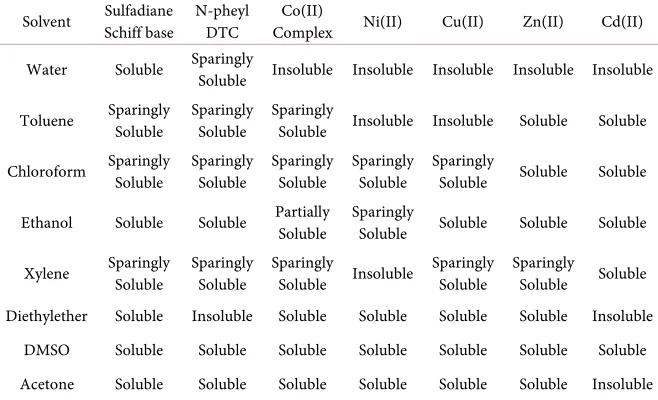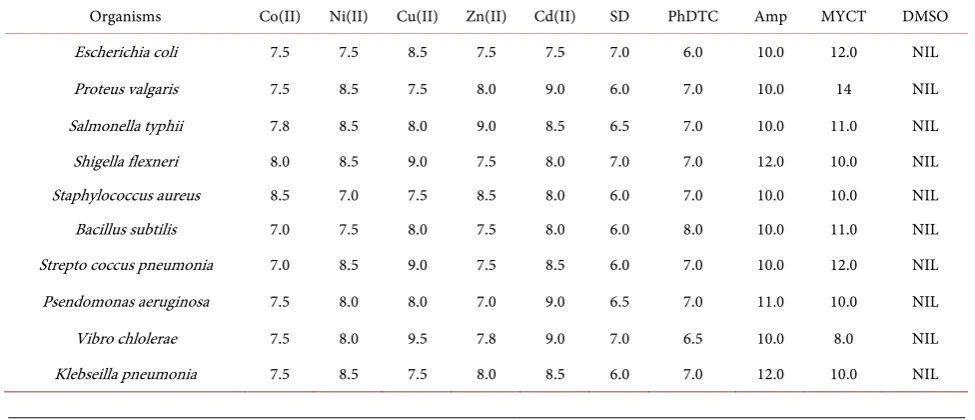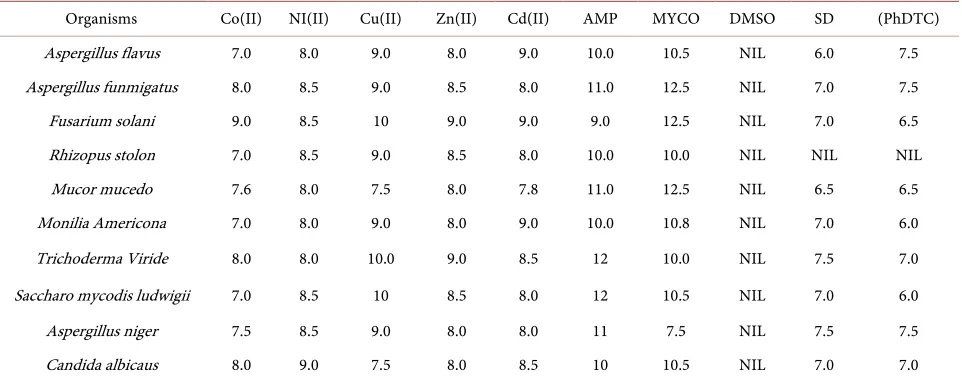ISSN Online: 2165-3925 ISSN Print: 2165-3917
DOI: 10.4236/ojapps.2018.88026 Aug. 28, 2018 346 Open Journal of Applied Sciences
Synthesis, Characterization and Antimicrobial
Activities of Sulfadiazine Schiff Base and Phenyl
Dithiocarbamate Mixed Ligand Metal
Complexes
Benjamin Chibuzo Ejelonu
1, Sulaiman Adeoye Olagboye
2, Oluwatoba Emmanuel Oyeneyin
1*,
Oladipo Adebayo Ebiesuwa
1, Oluwatomisin Emmanuel Bada
1 1Department of Chemical Sciences, Adekunle Ajasin University, Akungba Akoko, Nigeria 2Department of Chemistry, Ekiti State University, Ado Ekiti, NigeriaAbstract
Sulfadiazine Schiff base and Phenyl dithiocarbamate mixed ligand metal complexes have been synthesized and characterized. The characterization of metal complexes is based on the results of the solubility, colour, melting points and elemental analysis as well as the spectroscopic studies. The results obtained from the spectroscopic spectra revealed from the UV-visible showed the presence of chromophoric groups while the FTIR results confirmed that the metals coordinated through the two nitrogen atoms of Sulfadiazine Schiff base and sulphur atom of the N-phenyl dithiocarbamate. Also the antimicro-bial activities of the metal complexes proved that the metal complexes are more active than the parent ligands.
Keywords
Sulfadiazine Schiff Base, Phenyl Dithiocarbamate, Metal Complexes, Antimicrobial Activities, Spectral Studies
1. Introduction
Coordination compounds exhibit different characteristics properties which de-pend on the metal ion to which they are bound, the nature of the metal as well as the type of ligand etc. These metal complexes have found extensive application in various fields of human interest [1]. Schiff bases play important roles in coor-dination chemistry as they easily form stable complexes with most transition How to cite this paper: Ejelonu, B.C.,
Olagboye, S.A., Oyeneyin, O.E., Ebiesuwa, O.A. and Bada, O.E. (2018) Synthesis, Characterization and Antimicrobial Activi-ties of Sulfadiazine Schiff Base and Phenyl Dithiocarbamate Mixed Ligand Metal Complexes. Open Journal of Applied Sciences, 8, 346-354.
https://doi.org/10.4236/ojapps.2018.88026
Received: July 17, 2018 Accepted: August 25, 2018 Published: August 28, 2018
Copyright © 2018 by authors and Scientific Research Publishing Inc. This work is licensed under the Creative Commons Attribution International License (CC BY 4.0).
DOI: 10.4236/ojapps.2018.88026 347 Open Journal of Applied Sciences metal ions [2]. Schiff base complexes have remained an important and popular area of research due to their simple synthesis, versatility, and diverse range of applications [2][3]. Sulfadiazine Schiff base is formed from the reaction of sul-fadiazine and salicylaldehyde. Sulsul-fadiazine is a useful antibacterial drug with a typical sulfonamide structure. Salicyaldehyde is an organic compound described as a key precursor to variety of chelating ligand by condensation with amines [4].
Schiff bases derived from an amino and carbonyl compound are an important class of ligands that coordinate to metal ions via azomethine nitrogen and have been studied extensively [5] and reported for their antimicrobial, anti-inflammatory, antitumor, anticancer, antimalarial and anticonvulsant activity [6]. Metal com-plexes of N-phenyl dithiocarabamates are widely studied due to their biological, chemical, agricultural and industrial applications. The presence of the dithio-carbamate moiety in some biologically active molecules has necessitated interest in their potentials for medical application [7].
At present, due to increase in resistance to current generation of antibiotics, efforts are being made to develop novel chemotherapeutic targets. Development of metal based pharmaceutical has received tremendous attention [8][9] [10]. This work was therefore designed to synthesize, characterize and evaluate the antimicrobial activities of Sulfadiazine Schiff base and N-phenyl dithiocar-bamates mixed ligand metal complexes.
2. Experimental
2.1. Materials and Methods
All reagents used were of analytical grade. All chemicals were obtained from Sigma-Aldrich. All the reagents, starting materials as well as solvents were pur-chased commercially and used without any further purification. The melting points were recorded in melting point apparatus. Elemental C, H, N and S analysis were carried out on a Fison EA 1108 Micro analyzer. The Infrared (FTIR) spectra were recorded by using FTIR, 8300 Shimadzu spectrophotometer in the frequency range of 4000 - 400 cm−1. The ultraviolet-visible (UV-vis)
spec-tra were recorded by using Shimadzu UV-VIS. 160A ulspec-tra-violet spectropho-tometer in the range of 200 - 800 nm.
2.2. Synthesis of Metal Complexes
The sodium salt of the Sulfadiazine Schiff base was generated from sodium hy-droxide and Sulfadiazine Schiff base according to the following equation:
N
N NH S
O
O
N O H
H2O
+
Na
+OH
- NN N
Na S
O
O
N O H
DOI: 10.4236/ojapps.2018.88026 348 Open Journal of Applied Sciences 1.00 mmol (0.3704 g) sulfadiazine ligand was dissolved and stirred in 30.00 ml deionized water for ten minutes, this was followed by 1.00 mmol (0.0403 g) NaOH in 20 ml deionized water and the mixture was stirred for one hour. 1.00 mml metal salt (0.1298 g CoCl26H2O 0.2280 g CuCl2∙21/2H2O, and 0.2920 g
Ni(NO3)2∙21/2H2O, 0.1363 g ZnCl2, 0.2280 g CdCl2∙21/H2O respectively) dissolved
in 30 cm3 was gently added to the mixture while stirring continued for two
hours. Finally, 1.00 mmol (0.1860 g) aniline dithiocarbamate ligand dissolved in 30 cm3 was added to the mixture. The resulting mixture was then allowed to stir
for 3 hours. The precipitate formed was filtered, washed with deionized water, and the residue kept in a clean crucible and dried over silica gel in a dessicator.
Note: M = Co, Ni, Cu, Zn and Cd.
2.3. Antimicrobial Studies of the Ligands and Their Metal
Complexes
Ten different bacteria and ten fungi were collected from University of Ife Teaching Hospital, Ile-Ife, Osun state, Nigeria. They were sub-cultured on nu-trient agar for bacteria and potato dextrose agar for fungi. Both media were pre-pared according to manufacturer’s specifications. True representatives of each of the different organisms were sub-cultured, their identification and taxonomic studies were carried out to confirm each organism. The confirmed organisms were then prepared for use as test organisms for the antibiotic susceptibility test. Each of the test organisms was transferred to a liquid medium nutrient broth for bacteria and enriched peptone broth for fungi. They were inoculated for 18 h af-ter which they were used for the test.
Mueller-Hinton agar was prepared according to manufacturer’s specification, poured into petri dishes and allowed to set. Sterile swab were then used to seed the set agar plates with each test organism, then an 8 mm diameter cork-borer was used to bore wells in the plates, after which each wells was filled with the solution of each test compound.
3. Results and Discussion
3.1. Elemental Analysis
Elemental analysis of the metal complexes was determined to correlate between the calculated and experimental values of the percentage compositions of car-bon, hydrogen, nitrogen and chloride as contained in the metal complexes (Table 1).
NH
S S N
H HH H N N N Na S O O N O H
+M(II) H2O
N
N+ N M S S NH S O O N OH H
+ +Na++NH4+
DOI: 10.4236/ojapps.2018.88026 349 Open Journal of Applied Sciences
Table 1. Elemental analysis of metal complexes.
Metal complex Colour yield M. pt˚C % C H N Cl
[Co(II)(SD)PhDTC] Dark 54 295 (45.13) 44.86 (3.28) 2.933 (10.26) 10.15 (20.96) 21.44
[Ni(II)(SD)PhDTC] brown Dark 62 273 (43.75) 43.35 (3.28) 3.55 (11.08) 10.56 ---
[Cu(II(SD)PhDTC) brown Dark 59 290 (43.70) 42.36 (3.96) 3.77 (11.64) 10.57 (20.61) 21.22
[Zn(II)(SD)PhDTC] Colourless 64 248 (49.11) 49.08 (3.24) 3.80 (11.94) 11.88 (16.37) 1643
[Cd(II)(SD)PhDTC] yellow Milky 57 260 (45.47) 45.45 (3.00) 3.22 (11.05) 11.31 (15.16) 15.91
3.2. Solubility
All synthesized ligands and their corresponding metal complexes show appre-ciable solubility in dimethyl sulphoxide (DMSO) and other organic solvents such as ethanol, diethyl ether, acetone, propan-2-ol, among others. This finding suggests that the metal complexes are basically non-polar compounds (Table 2).
3.3. UV/Vis Absorption
The UV-Vis electronic spectra of the ligands and corresponding metal com-plexes were recorded in dimethyl sulphoxide between 2000 nm at room tem-perature. The electronic spectra of the synthesized metal complexes and the ligands are shown in Table 3. In the electronic spectra of the Co(II), Ni, Cu(II), Cd(II), complex shown in the table, three bands were observed. The complex showed a sharp peak of high intensity at 390 nm and the broad peaks at 412 and 500 nm respectively. When compared with those of the free ligands, it is evident that the peaks at 370, 340, 251 and 250 nm all shift to higher wavelengths indi-cating the chromophoric group of the ligands is involved in bonding with the metal ions in the complexes [11].
In the electronic spectra of the Co(II) complex shown in the table, three bands were observed. The complex showed a sharp peak of high intensity at 480 nm and broad bands at 500 and 600 nm respectively. When compared with those of the free ligands, we observe that the peaks at 370, 340, 251 and 250 nm all shift to higher wavelengths indicating the chromophoric group of the ligands is in-volved in bonding with the metal ions in the complexes [12][13]. On the other hand, Zn(II) complex did not so any sign of absorbance, indicating no d-d tran-sition for being colourless [14].
3.4. FTIR
From the FTIR data table, the bands shown at 1588, 1592 and 1580 cm−1 on
DOI: 10.4236/ojapps.2018.88026 350 Open Journal of Applied Sciences
Table 2. Solubility tests of the ligands and mixed ligand metal complexes.
Solvent Sulfadiane Schiff base N-pheyl DTC Complex Co(II) Ni(II) Cu(II) Zn(II) Cd(II)
Water Soluble Sparingly Soluble Insoluble Insoluble Insoluble Insoluble Insoluble
Toluene Sparingly Soluble Sparingly Soluble Sparingly Soluble Insoluble Insoluble Soluble Soluble
Chloroform Sparingly Soluble Sparingly Soluble Sparingly Soluble Sparingly Soluble Sparingly Soluble Soluble Soluble
Ethanol Soluble Soluble Partially Soluble Sparingly Soluble Soluble Soluble Soluble
Xylene Sparingly Soluble Sparingly Soluble Sparingly Soluble Insoluble Sparingly Soluble Sparingly Soluble Soluble
Diethylether Soluble Insoluble Soluble Soluble Soluble Soluble Insoluble DMSO Soluble Soluble Soluble Soluble Soluble Soluble Soluble Acetone Soluble Soluble Soluble Soluble Soluble Soluble Insoluble
Table 3. Spectroscopic studies of metal mixed ligand complexes.
λmax (nm) IR spectrum cm−1
COMPLEXES v(S=O) v(N-H) v(C-S) v(C=C) v(C-N) v(S-M) [Co(II)(SD)PhDTC] 600,500,480 1145 1600 1031 1480 1355 977 [Ni(II)(SD)PhDTC] 300,253,250 1153 1636 1092 1489 1324 940 [Cu(II(SD)PhDTC) 655,543 1140 1616 1089 1486 1323 938 [Zn(II)(SD)PhDTC] - 1156 1592 1088 1484 1278 995 [Cd(II)(SD)PhDTC] 510,412,390 1149 1580 1090 1487 1337 942 SD (Ligand) 375,335,251 - 1578 1081 1482 1279 911 [PhDTC] (Ligand) 370,340,250 - 1588 1081 1482 1278 971
Zn(II), Cd(II), Cu(II), Ni(II) and Co(II) complexes respectively. This shift in the absorption band of the free ligand to those observed in the complexes is a result of the coordination between the mixed ligand and the metal ion at the two sulfur atoms of the N-phenyl dithiocarbamate ligand which serve as bidentate sites for the ligand. In the same way, the shift observed at the absorption bands 1588, 1578, 1580, 1592, 1616, 1636 and 1600 cm−1 representing the v(N-H) vibrations
in the free ligand and the metal complexes respectively is an indication of the coordination that stretches between the nitrogen atoms of the Schiff base ligand to the central metal ion in the respective complexes [15] [16]. In Table 3. the strong bands observed in the free ligands at 971 and 911 cm−1 but with shifts in
the bands in the metal complexes at 977, 940, 938, 995, 942 cm−1 respectively.
The shifts in the bands indicating that coordination of metals to the ligands (M-S), also the new bands appearing between 1145 - 1156 cm−1 in the metal
[image:5.595.207.540.324.479.2]DOI: 10.4236/ojapps.2018.88026 351 Open Journal of Applied Sciences
3.5. Antimicrobial Activities
The data of the antibacterial and antifungi activities of the parent ligands and complexes are given in Table 4 and Table 5. Antimicrobal potentials of metal complexes and the parent ligands have been determined by measuring the di-ameter of the zone of inhibition. The organisms isolated include Escherichia coli, Proteus vulgaris, Salmonellaus pneumonia, Pseudomonas aeruginosa, Vibro chlolerae and Klebseilla pne typhii, Shigella flexneri, Staphylococcus aureus, Ba-cillus subtilis, Streptococ umonia bacteria and Fungi isolated are Aspergillus flavus, Mucor mucedo, Aspergillus niger, Candida albicans, Aspergillus flavus, Aspergillus fumigetus, Rhizopus stolon, Mucor mucedo, Monilia amaricana and Candida albicans.
The lowest MIC values of 7.0 mm and the highest inhibition concentrations 9.5 and 9.0 mm was observed with the metal complexes against all the bacteria and fungi isolates respectively. The Cu(II)complex show more antimicrobial ac-tivity against the selected pathogens than other metal complexes. Generally, all the metal complexes have performed moderately against both the bacteria and fungi isolates favourably and can be compared with the controls in both the an-tibacterial and antifungal agents.
[image:6.595.54.542.529.739.2]The data of the antibacterial and antifungal activities of ligand and complexes are given in Table 4 and Table 5. The data reveals that the complexes have higher inhibitory activities than the free ligand. The enhancement of the activity of ligand on complexation can be explained by Overtone’s Concept and Chela-tion Theory. This theory states that chelaChela-tion reduces the polarity of the metal atom by the partial sharing of its positive charge with donor groups and possible π-electron delocalization over the whole ring. This results in increasing lypo-philic character of the complex and favours the permeation of the complex through the lipid layer of cell membrane. The complex blocks the metal binding sites in the enzymes of microorganisms. Consequently the complex disturbs the
Table 4. Zone of inhibition in (mm) of the metal complex against various bacteria isolated at 10 mg/ml concentration.
Organisms Co(II) Ni(II) Cu(II) Zn(II) Cd(II) SD PhDTC Amp MYCT DMSO
Escherichia coli 7.5 7.5 8.5 7.5 7.5 7.0 6.0 10.0 12.0 NIL
Proteus valgaris 7.5 8.5 7.5 8.0 9.0 6.0 7.0 10.0 14 NIL
Salmonella typhii 7.8 8.5 8.0 9.0 8.5 6.5 7.0 10.0 11.0 NIL
Shigella flexneri 8.0 8.5 9.0 7.5 8.0 7.0 7.0 12.0 10.0 NIL
Staphylococcus aureus 8.5 7.0 7.5 8.5 8.0 6.0 7.0 10.0 10.0 NIL
Bacillus subtilis 7.0 7.5 8.0 7.5 8.0 6.0 8.0 10.0 11.0 NIL
Strepto coccus pneumonia 7.0 8.5 9.0 7.5 8.5 6.0 7.0 10.0 12.0 NIL Psendomonas aeruginosa 7.5 8.0 8.0 7.0 9.0 6.5 7.0 11.0 10.0 NIL
Vibro chlolerae 7.5 8.0 9.5 7.8 9.0 7.0 6.5 10.0 8.0 NIL
DOI: 10.4236/ojapps.2018.88026 352 Open Journal of Applied Sciences
Table 5. Antifungal activity of metal complexes at the minimum inhibitory concentration of 12.5 mg/ml.
Organisms Co(II) NI(II) Cu(II) Zn(II) Cd(II) AMP MYCO DMSO SD (PhDTC)
Aspergillus flavus 7.0 8.0 9.0 8.0 9.0 10.0 10.5 NIL 6.0 7.5
Aspergillus funmigatus 8.0 8.5 9.0 8.5 8.0 11.0 12.5 NIL 7.0 7.5
Fusarium solani 9.0 8.5 10 9.0 9.0 9.0 12.5 NIL 7.0 6.5
Rhizopus stolon 7.0 8.5 9.0 8.5 8.0 10.0 10.0 NIL NIL NIL
Mucor mucedo 7.6 8.0 7.5 8.0 7.8 11.0 12.5 NIL 6.5 6.5
Monilia Americona 7.0 8.0 9.0 8.0 9.0 10.0 10.8 NIL 7.0 6.0
Trichoderma Viride 8.0 8.0 10.0 9.0 8.5 12 10.0 NIL 7.5 7.0
Saccharo mycodis ludwigii 7.0 8.5 10 8.5 8.0 12 10.5 NIL 7.0 6.0
Aspergillus niger 7.5 8.5 9.0 8.0 8.0 11 7.5 NIL 7.5 7.5
Candida albicaus 8.0 9.0 7.5 8.0 8.5 10 10.5 NIL 7.0 7.0
metabolism pathways in cell, resulting in the extinction of microorganisms [17] [19].
4. Conclusion
Mixed ligand complexes of Sulfadiazine Schiff base and Phenyl dithiocar-bamates of Co(II), Ni(II), Cu(II), Zn(II) and Cd(II) ions have been synthesized and characterized using both the physical and spectroscopic methods. The re-sults obtained so far have indicated that metal complexes are non-polar and non-electrolytes. Metal complexes coordinate through two nitrogen atoms of Sulfadiazine Schiff base and of sulphur atom of Phenyl dithiocarbamate ligands. The antimicrobial studies revealed that metal complexes are more active against the isolated microorganisms than the parent ligands. All the complexes show bacterial and fungal growth inhibition in follow the order: control > metal com-plexes > parent ligands.
Conflicts of Interest
The authors declare no conflicts of interest regarding the publication of this pa-per.
References
[1] Dhanalaskshmi, M. (2013) Synthesis, Characterization and Antimicrobial Activity of Some Mixed Ligand Metal Complexes. Department of Chemistry, SFR College for Women, Sivakasi, 109-119.
[2] Ejelonu, B.C., Oyeneyin, O.E., Akele, O.E. and Olagboye, S.A. (2018) Synthesis, Characterization and Antimicrobial Properties of Pd(II), Cr(III), Ni(II) and Co(II) Metal Complexes of Aniline and Sulphadiazine Schiff Bases as Mixed Ligands.
American Journal of Chemical Research,2, 1-9.
DOI: 10.4236/ojapps.2018.88026 353 Open Journal of Applied Sciences
Complexes with Phenanthroline and Bipyridyl. International Journal of Chemical and Analytical Science,2, 1235-1240.
[4] Jameš, D. and Kreft, S. (2008) Salicylaldehyde Is a Characteristic Aroma Compo-nent of Buckwheat Groats. Food Chemistry, 109, 293-298.
[5] Saied, M.E.K., Shaker, L.S. and Khaled, A.B. (2001) Schiff Base Complexes Derived from Salicylaldehyde with Amine, [Ni(1,2-pn)2Cl2]·3H2O and [Cu(1,2-pn)2]SO4·2H2O,
as Complex Ligands. Synthesis and Reactivity in Inorganic and Metal-Organic Chemistry,31, 927-951.
[6] Onwudiwe, C.D. and Ajibade, P.A. (2011)Synthesis, Characterization and Thermal Studies of Zn(II), Cd(II) and Hg(II) Complexes of N-Methyl-N-Phenyldithiocarbamate: The Single Crystal Structure of [(C6H5)(CH3)NCS2]4Hg2. International Journal of Molecular Sciences, 12, 1964-1978.
[7] Manav, N., Mishra, A.K. and Kaushik, N.K. (2004) Triphenyl Phosphine Adducts of Platinum(IV) and Palladium(II) Dithiocarbamates Complexes: A Spectral and in Vitro Study. Spectrochimica Acta Part A: Molecular and Biomolecular Spectros-copy, 60, 3087-3092.
[8] Cohen, S.M. (2007) New Approaches for Medicinal Applications of Bioinorganic Chemistry. Current Opinion in Chemical Biology, 11, 115-120.
[9] Allardyce, C.S., Dorcier, A., Scolaro, C. and Dyson, P.J. (2005) Development of Or-ganometallic (Organo-Transition Metal) Pharmaceuticals. Applied Organometallic Chemistry, 19, 1-10. https://doi.org/10.1002/aoc.725
[10] Casini, A., Gabbiani, C., Sorrentino, F., Rigobello, M.P., Bindoli, A., Gelbach, T.J., Marrone, A., Re, N., Hartinger, C.G., Dyson, P.J. and Messori, L. (2008) Emerging Protein Targets for Anticancer Metallodrugs: Inhibition of Thioredoxin Reductase and Cathepsin B by Antitumor Ruthenium(II)—Arene Compounds. Journal of Me-dicinal Chemistry, 51, 6773-6781.
[11] Gulcan, M., Sönmez, M. and Berber, I. (2012) Synthesis, Characterization, and An-timicrobial Activity of a New Pyrimidine Schiff Base and Its Cu(II), Ni(II), Co(II), Pt(II), and Pd(II) Complexes. Turkish Journal of Chemistry, 36, 189-200.
[12] William, K. (1993) Organic Spectroscopy. 3rdEdition, Macmillan Education Ltd., London.
[13] Nakamoto, K. (1978) Infrared and Raman Spectra of Inorganic Coordination Compounds. 3rd Edition, Wiley, New York.
[14] Ajibade P.A., Kolawole, G.A. and O’Brien, P. (2007) Metal Complexes of 4-Amino-N-(2-Pyrimidinyl) Benzene Sulfonamide: Synthesis, Characterization and Antiprotozoal Studies. Synthesis and Reactivity in Inorganic, Metal-Organic, and Nano-Metal Chemistry, 37, 653-659.
[15] Ajibade, P.A. and Kolawole, G.A. (2008) Synthesis, Characterization, Antiplasmo-dial and Antitrypanosomal Activity of Some Metal (III) Complexes of Sulfadiazine.
Bulletin of the Chemical Society of Ethiopia, 22, 261-268.
[16] William, D.H. and Fleming, I. (1989) Spectroscopic Methods in Organic Chemistry. 3rd Edition, McGraw-Hill Book Company, New York, London.
[17] Shaker, S.A., Mohammed, H.A. and Salih, A.A. (2010) Preparation, Physio-Chemical and Spectroscopic Investigation of Thiacetazone Quinalizorine Complexes with Mn(II), Fe(II), Co(II), Ni(II), Cu(II), Zn(II), Cd(II) and Pd(II). Australian Journal of Basic and Applied Sciences, 10, 5178-5183.
DOI: 10.4236/ojapps.2018.88026 354 Open Journal of Applied Sciences
their Co(II), Ni(II), Cu(II), Pd(II), and Pt(IV) Complexes. Bioinorganic Chemistry and Applications,2009, Article ID: 413175.



